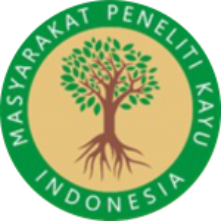Pengaruh Jenis Finir Dan Jumlah Perekat Terhadap Kualitas Plywood Interior
Effect of Veneer Type and Amount of Adhesive on Plywood Face Coating
DOI:
https://doi.org/10.22437/jsilvtrop.v6i2.23788Keywords:
adhesive, glue spread, plywood, veneerAbstract
Utilization of composite boards for furniture has been widely used in order to substitute solid wood. Coating veneer (veneering) is a technique to improve the appearance of composite panel products, such as plywood. This research was conducted to determine the effect of the type of veneer and the mass of adhesive lath on the physical and mechanical properties of veneering plywood. The veneer used are from teak, mahogany and mindi. The adhesive used was polyvinyl acetate (PVAc) with a melting weight of 130 g/m2, 150 g/m2, 170 g/m2. The results showed that the type of veneer had no effect on the physical and mechanical properties of the composite board. The physical properties in the form of density are affected by the weight of the adhesive, the higher the amount of adhesive, the higher the density. Veneer delamination with glue spread of 150 and 170 g/m2 complies with JAS Type 2 standards. Veneer composite products with PVAc adhesives can be used in interior areas where there is frequent short term exposure to water.
Keywords: adhesive, glue spread, plywood, veneer
ABSTRAK
Pemanfaatan plywood untuk furnitur telah banyak digunakan dalam rangka mensubtitusi kayu pejal. Veneering merupakan suatu teknik pelapisan permukaan untuk meningkatkan penampilan panel misalnya pada plywood. Penelitian ini dilakukan untuk mengetahui pengaruh jenis finir dan berat labur perekat terhadap sifat fisika dan mekanika veneering plywood. Finir yang digunakan adalah dari kayu jati, mahoni dan mindi. Perekat yang digunakan adalah polyvinyl asetat (PVAc) dengan berat labur 130 g/m2, 150 g/m2, 170 g/m2 . Hasil penelitian menunjukkan jenis finir tidak berpengaruh terhadap sifat fisika, mekanika papan komposit. Sifat kerapatan dipengaruhi oleh berat labur perekat, yaitu semakin tinggi berat labur maka kerapatan semakin meningkat. Delaminasi veneering dengan berat labur 150 dan 170 g/m2 memenuhi standar JAS Type 2. Produk komposit veneering dengan perekat PVAc dapat digunakan pada interior dan dapat perpapar kelembapan secara singkat.
Katakunci: berat labur, finir, perekat, plywood
Downloads
References
[BSN] Badan Standardisasi Nasional. 1999. Kayu Lapis Struktural. Jakarta: Badan Standardisasi Nasional.
[BSN] Badan Standardisasi Nasional. 2000. SNI 01-5008.7-1999 Kayu Lapis Penggunaan Umum. Jakarta: Badan Standardisasi Nasional.
Dundar T, Akbulut T, Korkut S. 2008. The effects of some manufacturing factors on surface roughness of sliced Makore (Tieghemella heckelii Pierre Ex A.Chev.) and rotary-cut beech (Fagus orientalis L.) Veneers. Build Environ 43:469–474.
Japanese Agricultural Standard. 2018. Japanese Agricultural Standard for Plywood JAS MAFF, Notification No. 683. Japan: Ministry of Agriculture, Forestry and Fisheries.
Jivkov V, Elenska-Valchanova D. 2019. Mechanical Properties of Some Thin Furniture Structural Composite Materials. International Conference on Wood Science and Technology: 86-94.
Khoo PS, Chin KL. Lee CL, H’ng PS, Hafizuddin MS. 2021. Effect of Glue Spreads on the Structural Properties of Laminated Veneer Lumber from Spindleless Rotary Veneers Recovered from Short Rotation Hevea Plantation Logs. Polymers 13: 3799.
Mardikanto TR, Karlinasari L, Bahtiar ET. 2011. Sifat Mekanis Kayu. Bogor: IPB Press.
Rahayu I, Darmawan W, Nugroho N, Marchal R. 2015. The Effect of Jabon Veneer Quality on Laminated Veneer Lumber Glue Bond and Bending Strength. J. Ilmu Teknol. Kayu Tropis 13: 98-110.
Shmulsky R, Bowyer JL, Haygreen JG. 2003. Forest Products and Wood Science. An Introduction, Fourth Edition. Iowa: A Blackwell Publishing Company.
Tsoumis G. 1991. Science and Technology of Wood: Structure, Properties, Utilization. New York: Van Nostrand Reinhold.
Walker JC. 2018. Primary wood processing: principles and practice (ed.2). Springer Science & Business Media.
Downloads
Published
How to Cite
Issue
Section
License
Copyright (c) 2023 Jurnal Silva Tropika

This work is licensed under a Creative Commons Attribution 4.0 International License.
















